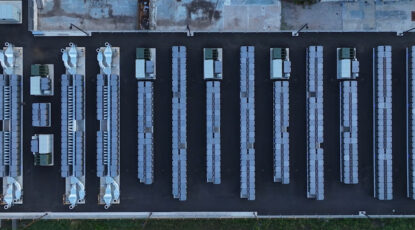Global demand for hydrogen is growing by the day—not the fossil fuel-derived hydrogen of the past, but a decarbonized hydrogen ready to power the decarbonized, clean energy future. According to the S&P Global current demand for hydrogen is estimated at 75.2 millon metric tons per year and is seen growing to 94.1 million metric tons per year by 2027. Other forecasts show it growing to 614 million metric tons per year by 2050.
Bloom Energy makes the technology needed to efficiently produce hydrogen in the cleanest way possible, and it has been proving, through key tests and demonstration projects, that its Bloom Electrolyzer™ is ready to meet that demand, both in the United States and around the world. The United States made clean hydrogen a priority in the Inflation Reduction Act in 2022, but Canada also is rolling out incentives to support production, as is the European Union.
A critical tool for decarbonization
The world is moving, inexorably, in the direction of decarbonization. Sector after sector is seeking ways to reduce or eliminate carbon dioxide emissions from the production and use of energy. For some aspects of our economies, like residential and commercial buildings, that will mean electrification.
Other industries, however, need a different approach: industries such as heavy transportation and buses, and those that make the literal building blocks of our society, from steel to concrete and glass. The production processes for these industries are all very energy intensive and do not lend themselves well to easy electrification. They need hydrogen, produced in ways that are far cleaner than the way hydrogen has been made in the past.
The transportation fuels of the future also need clean hydrogen, and they are going to need a lot of it. To make renewable diesel, it takes roughly three times as much hydrogen as the crude oil that has been used to make a barrel of regular diesel. And it’s not just renewable diesel: Fuels like ammonia and sustainable aviation fuel are either already being traded on their carbon intensity or will be soon.
Renewable electricity, nuclear power and hydrogen
The Bloom Electrolyzer supplants the conventional way of making hydrogen from fossil fuels. Instead of a dirty process that creates carbon emissions, our Electrolyzer efficiently uses lesser amounts of electricity to split water into hydrogen and oxygen. It can be paired with zero-carbon electricity, such as that produced by solar and wind power, as well as with the steam generated by nuclear power operations.
The hydrogen production tax credit included in the Inflation Reduction Act of 2022 will make our zero-carbon hydrogen cost competitive with conventional gray hydrogen, which is critical for decarbonizing hard-to-decarbonize industries like fertilizer, steel, cement, and aviation.
Bloom’s proof points
The solid oxide Bloom Electrolyzer produces hydrogen by splitting water molecules and is the counterpart of Bloom’s solid oxide fuel cell platform, the Bloom Energy Server®. The Bloom Electrolyzer operates at high temperatures, which means it requires less energy than low-temperature PEM and alkaline electrolyzers, two competing technologies to split water molecules. Electrolyzers are produced in both Bloom’s new, 164,000-square foot, multi-gigawatt (GW) manufacturing facility in Fremont, California and in Newark, Delaware, where we inaugurated 1 GW of facility capacity for an electrolyzer line in November 2022.
To demonstrate the efficiency of its technology, Bloom has put its electrolyzer through rigorous, independent testing at the Idaho National Laboratory (INL). In August 2022, after nearly 500 hours of full load operation, INL found that Bloom’s high-temperature electrolyzer produced hydrogen more efficiently than other commercially available electrolyzers, including PEM and alkaline. Efficiency is key because the cost of electricity is up to 80 percent of the cost of hydrogen production through electrolysis. By producing hydrogen up to 45 percent more efficiently than PEM and alkaline electrolyzers when combined with external heat, the Bloom Electrolyzer puts clean hydrogen on a path to become economically viable.
Industries that could be opportunities for clean hydrogen are beginning to take notice. LSB Industries, the leading North American producer of industrial and agricultural chemicals, announced in May 2022 that it would install 10MW of Bloom electrolyzers at its Pryor, Oklahoma facility. The project is expected to generate green hydrogen that will contribute to the synthesis of approximately 13,000 metric tons of zero-carbon ammonia per year. In September 2022, Bloom said that it is installing an electrolyzer at Xcel Energy’s Prairie Island Nuclear Generating Plant in Welch, Minnesota. The electric utility sees the project as opportunity to understand how its nuclear plants can contribute to the development of hydrogen technologies and a carbon-free future.
History will record 2023 as the year when a new kind of electrolyzer made clean hydrogen commercially available—and commercially viable. Bloom Energy has laid the groundwork for the next big step in the transition to a clean energy economy.
Rick Beuttel is vice president of hydrogen business at Bloom Energy. Follow him on LinkedIn.



